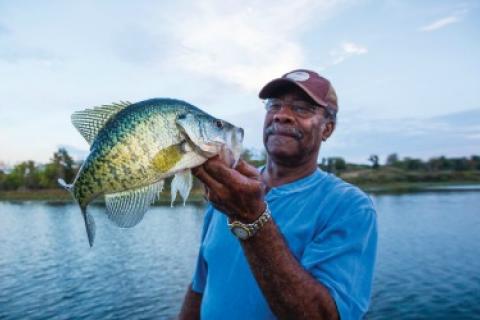
Ah, what could be more traditional than a fishing rod, a bobber, and a frisky minnow on a hook? It harkens to childhood days of panfish, popsicles, and not a worry in the world until school started again.
While you may have graduated from the red and white bobber, floats can still be a valuable piece of your fishing arsenal. Whether you’re six or 60, here’s why they should have a place in your tackle box this summer:
 |
| Using a float to slow your presentation can result in some of the biggest slabs of the summer. |
Keep Your Bait in the Strike Zone
Floats affixed to your line keep the bait in one location—that’s the simplicity of them. Crappie are notorious for holding at specific depths, especially during the summer months. When the water warms and the fish become sluggish it can be essential to keep your bait right in front of their faces. Floats take the guesswork out of the equation.
This is when it really helps to be in sync with your sonar unit. After you mark crappie on your unit, simply set your bait depth with a float. Small adjustments are easy to make until you find the fish, and then you’ll be able to hit the sweet spot every time.
Don’t Snag in Heavy Cover
Casting to cover without a float requires you to play the pendulum of the bait on the fall, and can often result in wrapping your line around a limb. A vertical drop can spook fish or be downright impossible in some situations.
With a float you are able to fire the lure into a boat slip, flip it gently beside a treetop, or cast down a riprap bank without worry. Careful depth control also allows you to keep your bait right above submerged brush piles or weedbeds—close enough to entrice a strike but a safe distance from constant snags.
Detect Subtle Bites
Floats are also great indicators that a fish is biting. The visual twitch is solid confirmation that a fish is at the other end, rather than a rock or limb. A float can also provide less resistance on soft-biting fish—giving you enough time to set the hook.
If the bite is subtle then a lightweight, thin float may be necessary. Some floats come light enough to detect the breath of a passing slab—but keep in mind these are the same ones that tend to get blown to the other side of the lake when the wind kicks up. A larger float may not reveal soft bites, but if crappie are whackin’ it hard you can get by with a more steady option.
Slow Down Your Presentation
When the summer sun is high, crappie do the sensible thing—they look for a shady spot to rest. They’re a lot like you when kicked back in your favorite recliner. They aren’t going to expend a lot of energy to eat, but if the opportunity presents itself, they’ll probably take advantage of it.
Using a float is typically thought of as a live-bait tactic, but it works great for artificials too. Dangling a marabou jig, soft-plastic critter, or tube jig under a bobber can produce surprising results. The subtle motion a slight chop on the water can provide is often enough to entice a bite. On calm days, the occasional twitch will do the trick.
Bonus Tip: Camouflage Your Float
Here’s one thing I learned from Jim Duckworth and it’s a darn good bit of advice: if your floats have a white bottom, paint them green or light blue. This keeps the float from shining in clear water. Crappie look up to feed and if you’re in clear water or it’s a shy bite, the white bottom on the float will stick out.
Take a Sharpie pen in green or blue and give it some color. I’ve used a black pen, too, and made thick zebra stripes to break up the outline.
After you float your way to a stringer of slabs be sure to share a photo with us on our Braggin' Board!
- 8629 views

